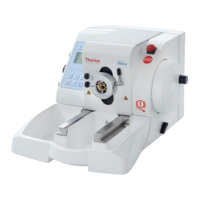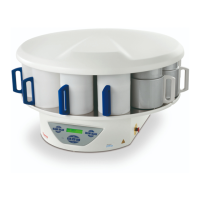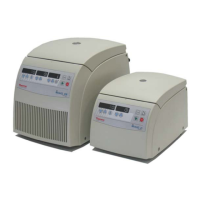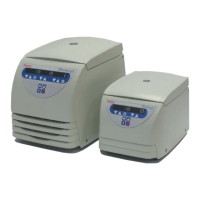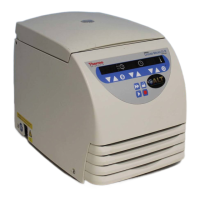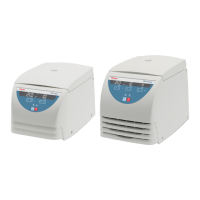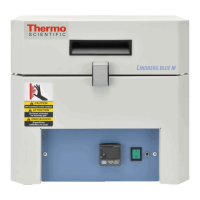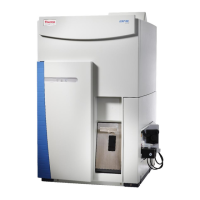Do you have a question about the Thermo Scientific Microm HM 430 and is the answer not in the manual?
Explains symbols like Note, Warning, Caution, Hand Injuries, Biohazard, Radioactivity.
Instructions for separate collection of electrical/electronic instruments.
Safety instructions for handling and using the microtome knife.
Warnings against operating the instrument in explosive environments.
Safety procedures for working with radioactive specimens.
Details the features and applications of the HM 430 microtome.
Instructions for unpacking and positioning the microtome for operation.
How to set the desired section thickness using the scaled wheel.
How to use the standard specimen clamp for rectangular/square blocks.
Instructions for a second standard specimen clamp with transverse clamping.
How to adjust the clearance angle of the knife using screws.
Steps for inserting and clamping disposable blades into the holder.
How to adjust the clearance angle for disposable blades.
Importance of using the knife guard for safety during adjustments.
Catalog numbers for different disposable blade holders.
Catalog numbers for universal and standard specimen clamps.
Catalog numbers for optional height adjustment plates.
Catalog numbers for various steel and tungsten carbide microtome knives.
Catalog numbers for knife cases.
Catalog numbers for disposable paraffin blades.
Catalog numbers for fast freezing unit and paraffin repellent.
Explains the microtome's cutting mechanism using linear roller bearings.
Preparing and orienting specimens before sectioning.
Using coarse feed/trimming to adjust space between specimen and edge.
Importance of using a sharp knife and how to manage blunt edges.
Importance of clean knife surfaces for optimal sectioning.
Ensuring proper specimen preparation, embedding, and fixation.
Maintaining correct specimen temperature to avoid paraffin softening.
Ensuring all clamping screws and levers are properly tightened.
Importance of selecting the correct knife material and profile.
Proper adjustment of the knife's clearance angle.
Selecting the appropriate cutting speed based on material hardness.
Care required when bringing the knife and specimen together for trimming.
Recommendation for annual routine maintenance by a trained technician.
Information on Thermo Scientific service contracts for instrument maintenance.
Factors influencing cleaning frequency and suitable cleaning agents.
Steps for cleaning the microtome, knife, and components.
Procedures for returning the instrument for service, including packaging.
Steps for closing down the instrument before transportation.
Explains symbols like Note, Warning, Caution, Hand Injuries, Biohazard, Radioactivity.
Instructions for separate collection of electrical/electronic instruments.
Safety instructions for handling and using the microtome knife.
Warnings against operating the instrument in explosive environments.
Safety procedures for working with radioactive specimens.
Details the features and applications of the HM 430 microtome.
Instructions for unpacking and positioning the microtome for operation.
How to set the desired section thickness using the scaled wheel.
How to use the standard specimen clamp for rectangular/square blocks.
Instructions for a second standard specimen clamp with transverse clamping.
How to adjust the clearance angle of the knife using screws.
Steps for inserting and clamping disposable blades into the holder.
How to adjust the clearance angle for disposable blades.
Importance of using the knife guard for safety during adjustments.
Catalog numbers for different disposable blade holders.
Catalog numbers for universal and standard specimen clamps.
Catalog numbers for optional height adjustment plates.
Catalog numbers for various steel and tungsten carbide microtome knives.
Catalog numbers for knife cases.
Catalog numbers for disposable paraffin blades.
Catalog numbers for fast freezing unit and paraffin repellent.
Explains the microtome's cutting mechanism using linear roller bearings.
Preparing and orienting specimens before sectioning.
Using coarse feed/trimming to adjust space between specimen and edge.
Importance of using a sharp knife and how to manage blunt edges.
Importance of clean knife surfaces for optimal sectioning.
Ensuring proper specimen preparation, embedding, and fixation.
Maintaining correct specimen temperature to avoid paraffin softening.
Ensuring all clamping screws and levers are properly tightened.
Importance of selecting the correct knife material and profile.
Proper adjustment of the knife's clearance angle.
Selecting the appropriate cutting speed based on material hardness.
Care required when bringing the knife and specimen together for trimming.
Recommendation for annual routine maintenance by a trained technician.
Information on Thermo Scientific service contracts for instrument maintenance.
Factors influencing cleaning frequency and suitable cleaning agents.
Steps for cleaning the microtome, knife, and components.
Procedures for returning the instrument for service, including packaging.
Steps for closing down the instrument before transportation.
| Microtome Type | Rotary Microtome |
|---|---|
| Section Thickness Settings | 0.5 µm increments |
| Trimming Thickness Settings | 1 µm increments |
| Vertical Specimen Stroke | 60 mm |
| Application | Histology, Pathology |
| Section Thickness Range | 0.5 - 60 µm |
| Trimming Thickness Range | 1 - 60 µm |
| Specimen Orientation | Horizontal |
| Specimen Illumination | LED |
| Blade Type | Disposable blades |
| Power Supply | 230 V / 50 Hz or 115 V / 60 Hz |

